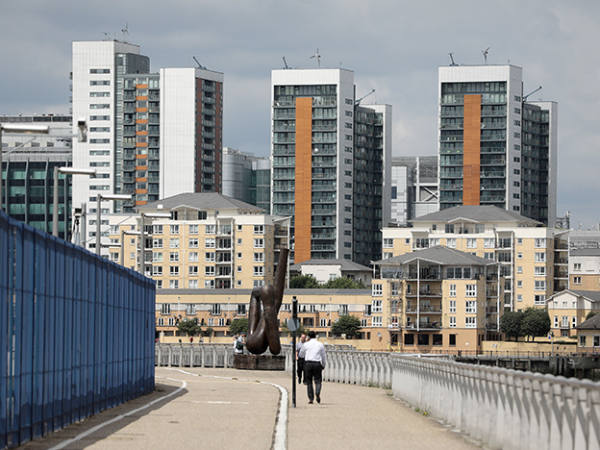- Property is meant to be a good inflation hedge
- Tenant demand remains the key driver
In the year to January, UK inflation hit 5.5 per cent, its highest level in three decades. The Bank of England thinks the figure could reach 7 per cent during 2022, while some economists suspect that forecast could climb again if the Russia-Ukraine situation adds another leg to spiking energy prices.
Owners of a range of assets, from cash to bonds and shares in high-growth companies, are fretting. In recent weeks, those nerves appear to have extended to real estate investors (see chart), despite property’s historic reputation as a good inflation hedge. If prices rise – or so the theory goes – then rental income should follow, in turn boosting asset valuations. As inflation pushes up the price of labour and materials, higher replacement costs only add to the growth in capital value.
Recent history bears this out. Cushman & Wakefield, the real estate services group, found that every 1 per cent increase in inflation between 2003 and 2021 was associated with a 1.1 per cent increase in total returns earned in private real estate, and a 4.5 per cent increase for publicly listed real estate investment trusts (Reits), despite higher levels of volatility in the latter.
Still, is the kind of sharp spike we are seeing right now enough to test those safeguards and assumptions?
“It’s not as black and white as that,” argues Marcus Phayre-Mudge, fund manager of the TR Property Investment Trust (TRY). “If it is supply side inflation, then the question is how much central banks can contain. If it is demand-driven, then you could say economies are warming up and you will capture that in rental growth – subject to there not being a surge in supply in said asset class.”
In other words, real estate owners can afford to be sanguine about the principal drivers of inflation. If it is a result of broad-based rising demand within the economy, then this should give landlords some pricing power; if the cost of raw materials and labour is suddenly climbing, then the cost of capital to build new real estate rises, thereby restricting new supply.
Regardless of the ultimate driver of inflation, property companies have tools at their disposal to manage its effects on rental income, including a preference for shorter lease lengths, frequent rent reviews, and clauses stipulating rental uplifts linked to inflation (also known as indexation).
TR Property, which invests in both listed and physical property, appears well-placed to weather any inflation headwinds, given its strong exposure to the European real estate market where the use of long-term, indexed leases is widespread. Closer to home, Reits including LXI (LXI), LondonMetric (LMP) and healthcare landlords Primary Health Properties (PHP) and Assura (AGR) all make strong use of indexation in their lease agreements.
Phayre-Mudge also thinks investors should pay attention to property groups whose chief financial officers extended debt maturities at low interest rates before the recent spike. Given higher inflation effectively erodes the real value of any loan, then fixed-interest debt provides significant benefits to borrowers.
With the benefit of hindsight, some of the sector’s recent debt issues look particularly shrewd. For example, at the end of 2020, Tritax Big Box (BBOX) sold a £250mn bond maturing in 2033 at a 1.5 per cent coupon. The fact the bond currently trades at 13 per cent discount is less a sign of fixed income investors’ concerns with the group’s long-term prospects, than the fact that near-term coupon payments now barely offer a premium over with gilts (see chart).
Similar discounts are now already applied to the two bonds issued last year by Sirius Real Estate (SRE) implying the German business park specialist got its timing right. The two transactions, which saw Sirius raise €400mn (£334mn) in June and €300mn in November at five and seven-year tenures, respectively, also provided an insight into debt markets’ shifting yield appetite. Less than half a year after agreeing to a 1.125 per cent coupon, the market required 1.75 per cent for the €300mn bond.
Persistently low eurozone interest rates, which in 2019 allowed Sirius to borrow €113m for four years at 0.9 per cent, are arguably another attraction of European property markets at a time of rising inflation. Whether out of necessity or faith in a combination of central bank bond buying and a return to low inflation, eurozone debt investors appear happy to set 0.27 per cent as their 10-year risk-free rate. Such a mismatch is good news for any company which believes it can grow rental income and is prepared to borrow on a five-year time horizon, European property owners included.
Sirius and Tritax are also fortunate enough to benefit from strong tenant demand. In sectors of the property where demand is weaker – such as non-premium offices and shopping centres – inflation could pose more of a challenge. “Over the medium term we continue to believe the overriding determinant in capturing rental growth equal to or above inflation is the quality of the underlying assets, which ultimately boils down to tenant demand,” said Peel Hunt in a recent note to clients.
Indeed, the property cycle, and the uneven tailwinds and headwinds it creates, means inflation should remain a second-order concern for growth-oriented investors. Few economists, for example, expect UK inflation to remain at 5 per cent for the next three years. And yet that is what CBRE believes will happen to annual rental growth in the UK industrial and logistics market, which explains why many asset buyers in the sector are happy to wave indexed leases in favour of open market rent reviews.














